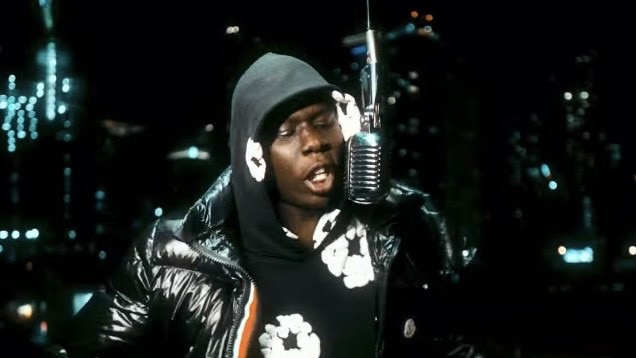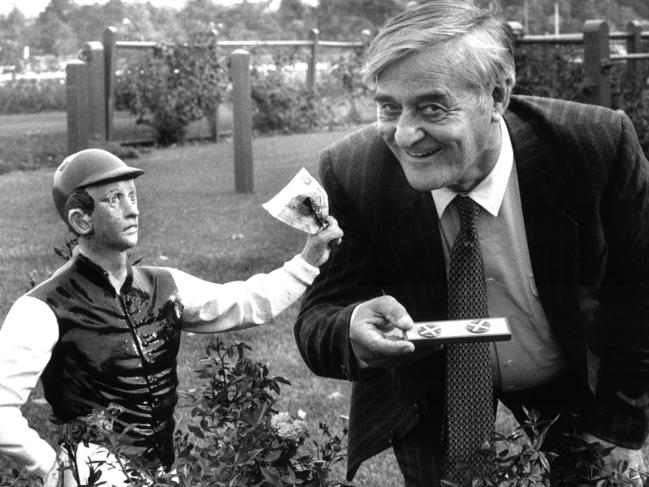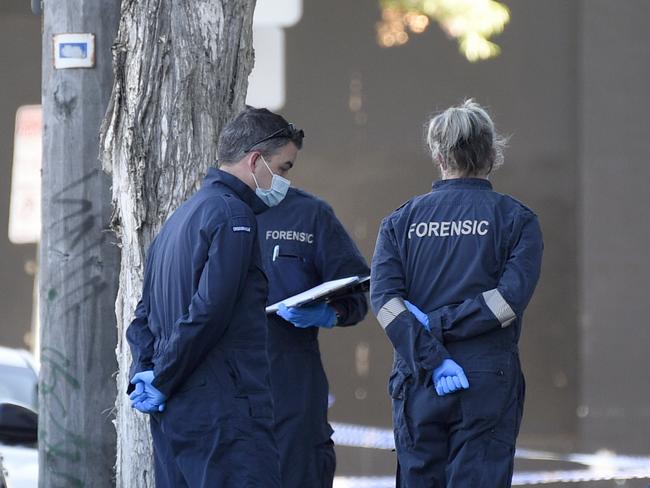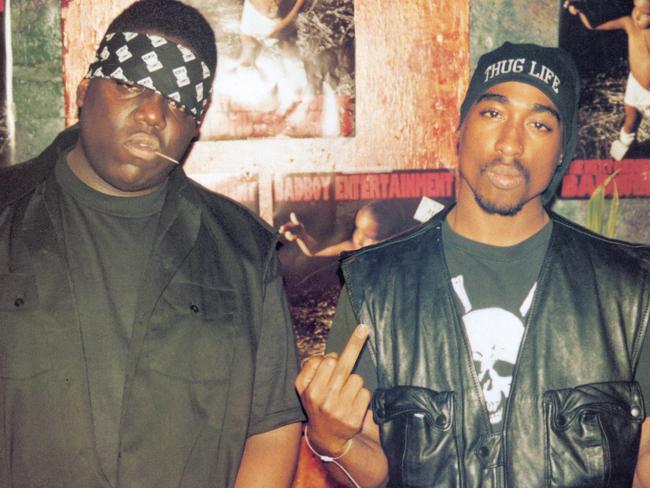Rap can be a dangerous game – even in Melbourne
Not every rapper is a wannabe gangster but a lot of wannabe gangsters tap into rap’s “street” culture of violence, sex, guns, drugs and prison.

Andrew Rule
Don't miss out on the headlines from Andrew Rule. Followed categories will be added to My News.
Times change and so do crimes, but locations not so much. Such as the one where a young rapper was shot dead in the back streets of North Melbourne last weekend.
There was a time when locals heading from Kensington and Newmarket to the city would cut down Langford St near the North Melbourne football ground, heading past the Lost Dogs’ Home to Arden St.
Some nights in the 1980s, a driver would see a shady figure hanging around the front of a supposedly unused warehouse. It was a “cockatoo”, keeping watch for a police raid (or armed robbery) on the floating two-up school inside.
Before governments decided to cash in by licensing casinos to score a cut of the action, Nappy Ollington’s illegal two-up game was an institution among cashed-up crims riding their luck.

Like SP bookmakers, two-up was officially illegal but half tolerated. Among the up-and-coming gunmen who “minded” the game or played it for big bets were names that would become infamous in the gangland war 20 years later: Kanes, Morans and the like. Plus the odd undercover cop or rogue detective.
Nappy’s game died before he did. But the attraction of turning over fast money still draws a rather different crew to Langford St after dark these days, even if the tendency to carry guns hasn’t changed.
The word “rave” covers a lot of ground. So does “fight night”. For residents on the dark side of North Melbourne the raves held in Langford St and the fight nights a few blocks away at the Melbourne Pavilion have a whiff of Detroit or Los Angeles that does nothing for local real estate values.
There’s a sense, maybe, that both venues are patronised by people with too much illicit cash to go with chunky gold chains and ostentatious cars.
A vibrant multicultural community is one thing, a gang war zone is something else.
Nothing good happens after 2am, the saying goes. Add an hour and the risks only get worse.
It was after 3am last Saturday morning when young Sudanese rapper Pal “Peezy” Bidong was shot dead in Langford St outside a Halloween-themed rave.
Despite claims to the contrary, the 20-year-old’s death seems linked to tensions between rival gangs from west and east sides of the city.
As word of the shooting spread that morning, violent scenes erupted on the street. Police were forced to form a line to protect the crime scene from the brawling youths.
The precise circumstances of Bidong’s death are apparently a mystery, given that various members of the Sudanese migrant community vehemently disagree about it.
Suburban lawyer and South Sudanese spokesman Kot Monoah backed police warnings against retaliation attacks, urging families to keep young people home. But the dead man’s brother Nyot Bidong scoffs at that, claiming that any warnings against violent payback automatically smear all African youths as lawless thugs.
Nyot is pushing the line that his kindly, innocent brother was just in the wrong place at the wrong time when a stray bullet hit him for no good reason. That might even be true. But it does have the “no idea who dunnit” ring to it that the late Carl Williams tried to sell to sceptical police after Jason Moran shot him in the belly in 1999.
Carl was soon found to be lying through his teeth. The truth about Peezy Bidong’s life and times is still out there and will no doubt be unravelled in time.
For police, meanwhile, it’s a case of “damned if you do and damned if you don’t.”
One side claims that police (and media reports of gang-related activity) perpetuate “a false narrative” that fuels “damaging stereotypes” of young African people.

Police are also being criticised for not actively intervening in the street brawls that broke out after Bidong’s killing — intervention that would inevitably lead to footage of cops forcibly handcuffing African youths. Which would, of course, perpetuate a damaging and unfair stereotype of police as racist bullies rather than a buffer between civilised society and those who threaten it.
So, as the hunt continues for the mystery shooter, police are fending off cheap shots from all sides.
The last thing this column wants to do is perpetuate damaging stereotypes, but it’s a truism that the link between rappers and “gangstas” goes back a long while.
Not every rapper is a genuine wannabe gangster but a lot of wannabe gangsters tap into rap’s “street” culture of violence, sex, guns, drugs and prison. Most rap lyrics make the Taliban look like feminist Methodist missionaries. You couldn’t print them in a family newspaper.
Another Melbourne Sudanese rapper is BBG Smokey, more accurately known as Sean Deng. At the launch of his record company, 66 Records, in 2018, a street brawl outside the Gasometer Hotel in Collingwood ended with a teenager losing his leg after being rammed with a car.
Someone speaking for 66 Records said at the time that Deng’s music was about “his friends who’ve been dealt an unfair hand with the law.”
Unfair? It’s fair to say the police were intrigued that the flashy cars in BBG Smokey Deng’s music video belonged to members of the Notorious Crime Family gang or their associates. A clue to this, apart from the ostentatiously expensive cars and a gold-plated Harley-Davidson motorcycle, was that several customised number plates started with the letters NCF.
The police were so interested in the provenance of the vehicles, including a $250,000 Lamborghini Huracan, that they seized them to sell off as proceeds of crime.
The Notorious Crime Family’s name has its origins in rap. As in the ill-fated Brooklyn rapper Notorious B.I.G., alias Biggie Smalls, neither of which names are on his death certificate.
Biggie copped a bullet when he made the mistake of visiting Los Angeles in 1997 after conducting a deadly east coast v. west coast vendetta with fellow rapper Tupac Shakur that ended with both rappers dead.
Australian rappers are minnows compared with the Americans who invented rap. But the gangsta delusions are shared on this side of the Pacific.

Notorious Crime Family is virtually the trading name of the notorious George Marrogi, who is serving a long sentence after murdering Kadir Ors in his line of work, which is where drug trafficking meets contraband tobacco.
Life and Crimes with Andrew Rule
George’s younger brother, Jesse, left Australia suddenly around the time George was found guilty of the Ors murder. He returned to make a rare public appearance at the wedding of fellow gangster Jimmey Barkho in 2022.
Guests did burnouts in the car park and the groom wore an $80,000 watch. Enough said.
BBG Smokey, meanwhile, is still rapping. Where he stands on the death of his fellow artist Peezy Bidong is a matter for him. But maybe he should study the acknowledged godfather of the form, the late Coolio, whose rap classic Gangsta’s Paradise includes one warning line that can indeed be run in a family newspaper.
“You better watch how you talkin and where you walkin
Or you and your homies might be lined in chalk.”



